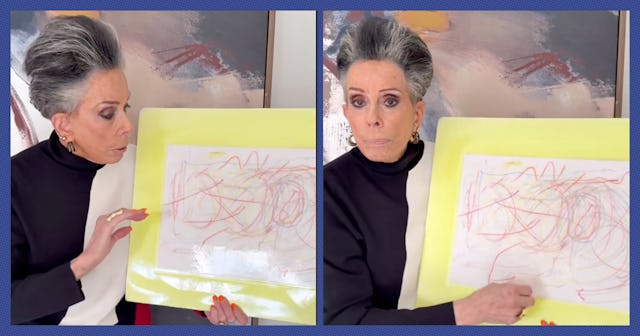An Artist Explains How To Talk To Your Kids About Their Art
This is actually really brilliant.

While my oldest child has never expressed all that much interest in making art, I don’t think my youngest has gone one day without making something since they were old enough to pick up a crayon, pencil, or crochet hook. Now that they’re in double digits, it’s easy to know what they’re making and know how to talk about what’s going on in a particular project. But when they were a toddler, I often found myself in the awkward position of always trying to figure out new ways to talk about paint splatters, mounds of Play Doh that don’t look like anything, and, of course, scribbles. But over on TikTok, Susan Striker (@susanstrikeryoungatart) an award-winning art educator and best-selling author of the Anti-Coloring Book series, has some ideas about how to talk to your toddler about their scribbles. It turns out it’s actually pretty important.
“This is not just a scribble,” she explains, holding up a picture that, I’ll be honest, looks like just a scribble to me. “This is an introduction to fluency and literacy for your child.”
Intriguing! Striker starts by explaining what not to do.
“Don’t just say ‘Very pretty, honey!’ and throw it in the garbage. That is not what this is about,” she begins. “This is about...” she points to one particular part of the drawing. “Diagonal lines — ‘Oh, aren’t you smart, sweetheart! You made a diagonal line! And look at this: a curved line and a straight line. You’re so clever. Look, I see a zig-zag! I see a horizontal line! You’re a genius! ... Are you sure you’re only 3 years old?!’”
Striker also encourages parents, caregivers, and teachers not to liken a child’s work of art by comparing it to more complex objects. You know how sometimes you look up at the sky and say that cloud is shaped like a whale and that one looks like a volcano or whatever? We’re going to avoid that impulse.
“What it reminds you of will come much, much later,” she explains. “You describe light next to dark. You describe how close things are. That’s the way to talk to a child about art.”
Basically, this is about the building blocks at this stage: paying attention to little details can help your child get a grasp not just of art but literacy. What is competent reading but paying attention to the little details that make up a whole. Grounding your children in their observations can help them thoughtfully analyze all kinds of art, visual, literary, and otherwise.
You’re also speaking to them in concrete details they can understand — abstract thought can be a bit much for a 2-year-old. They might not get that their drawing makes you think of a squirrel or why, but they can understand that you see “red,” “straight,” “close,” big,” “little.”
Basically, this is great news for parents: by being super literal (and showering them with praise) we can not only give them a nice little self-esteem boost but we can help them develop their artistic skills and powers of observation to do more complex, thoughtful artwork down the line.